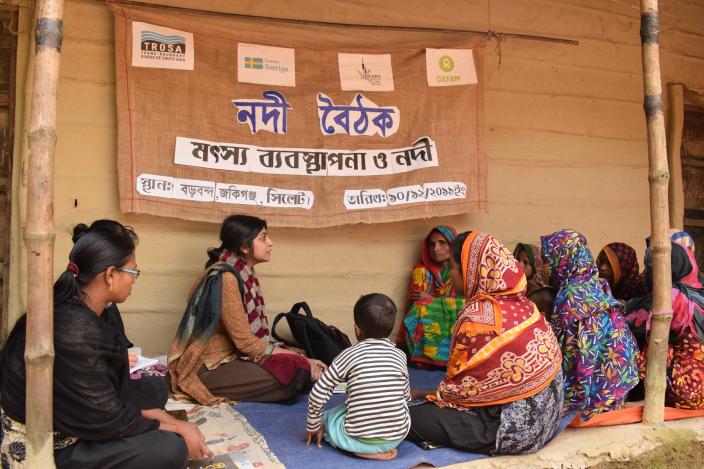It hasn't been long that I have been advocating for river governance. Having grown up in an urban city like Dhaka, I had a minimal connection with rivers. So, let alone thinking of river governance, I had a little knowledge and idea about the geography and character of rivers. However, as a part of my work, I kept visiting the rivers and meeting its people, which gradually helped to develop my understanding of rivers. So, on the eve of world water day, I would like to share my understanding of river governance from the lens of riverine communities through this writeup.
Tales of Riverine Communities
Like I was saying, through my continuous exploration of unknown rivers and its people, I gradually developed a deep connection with the rivers. Through my travel, I could connect with the struggles of river dependent communities. Mainly fisherfolks, farmers, boat dwellers, and internally displaced people who are the victim of river erosion. But, the thing that never ceased to surprise me that, amid their struggles, these group of people accepted me and my work with exceptional warmth and love. However, the much closer I drew towards them, the more precise vision of the injustice I could sense towards them. I saw that despite having the greatest stake in rivers, these groups of people are excluded from taking the decisions. It is directly affecting their lives. They are not consulted when any decisions related to their rivers are being taken place. As a result, they suffer from injustice for any wrong decision made on behalf of them.
For instance, I can relate this to my experience of visiting the community of Jhalor Char area, one remote village from the northern part of Bangladesh. This area represents a drying river with eroded banks. There, I observed some scattered bamboo made structures, locally known as Bandals, implemented by government agencies, on the river banks, ineffective against river erosion. Talking to the community, I found out that the people were not consulted before these Bandals were initiated. Even though some of them wanted to participate and give their opinions in the time of Bandal installations, they didn't get any scope for voicing out their concerns. Right now, these structures are somewhat ineffective to tackle erosion.
My observation from these field visits to riverine areas tells me that, if the people can identify and address solutions by themselves, it would bring better results for them. Besides, making decisions for themselves is the right of riverine communities. Being excluded from the river governance system make them more marginalized and helpless. Through a conversation with the community, I can sense that they possess a deep-rooted traditional knowledge that they have gained by living near the river. In this regard, I would like to mention about the success stories of strong community leadership in Namapara village. The village represents a riverine community who face severe erosion every year. And, most of the villagers have lost their homes 4 to 5 times in their lifetime. To minimize the impact of this river induced disasters, these communities themselves have installed Bandals as well. They have sat among themselves to identify the proper place in the river for Bandal installation. They have also involved the local government body in their whole process. They have even collected resources among themselves, along with managing money to implement those Bandals. And, this active community participation brought much better results to manage erosion in comparison to other areas, where there was no scope of community consultations.
I would also like to mention another case of exclusion in river governance. If I talk about fisheries, the governance of Hilsa fish, our national delicacy, has demonstrated the same picture. In our country, there are 22 days of the ban on catching Hilsa and 3 months ban for catching Juvenile Hilsa. And I cannot deny the fact that this policy has successfully managed to revive the production of Hilsa and it has proved to be effective in terms of conservation. However, when I dig deeper into the current management regime and look at it through the human rights lens, the governance system needs to readdress specific issues. Such as gender issues, geographic and benefit-sharing equity across all the value chains of Hilsa needs to be incorporated. To shed more light on this, I can refer to the compensation packages which are only 30-40 kgs of rice per family, very minimal to sustain their living. Whereas in most cases, the fisherfolks don't get the compensation packages, the average of these packages per family is also less than US one dollar per day, far below the poverty line. Besides, if I look at these compensation packages from the gender lens, women in fisheries are not considered at all when devising these packages for fisherfolks. So, all these factors compel them to engage in illegal fishing, and consequently, they have to pay a huge cost for defying the ban. All these factors make them more marginalized, and they remain trapped in the vicious cycle of poverty because of this exclusionary governance practice
Way Forward
Apart from that, my overall observation tells me that the water governance-related policies in our country are not conducive to the needs of river dependent communities. So, this is where my advocacy is most concentrated; creating a space for voicing out the community's concerns and knowledge for river-based decisions.
As I stated before, I strongly believe in the knowledge of communities of rivers. All we need to do is create a space for them through different platforms like community-led meetings, dialogues, etc. Although this community has their share of knowledge, it's our responsibility to guide them in the right direction and connect them with the right people in decision making. The interface among them is essential to realize the importance of community consultations in river governance and hence, ensure inclusive water governance.
